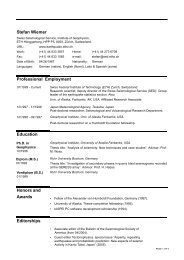zmap a tool for analyses of seismicity patterns typical applications ...
zmap a tool for analyses of seismicity patterns typical applications ...
zmap a tool for analyses of seismicity patterns typical applications ...
Create successful ePaper yourself
Turn your PDF publications into a flip-book with our unique Google optimized e-Paper software.
this case, the routine found that a simple shift <strong>of</strong> +0.1 units applied to the background,<br />
would best fit the <strong>for</strong>eground, while if a stretch is chosen, one needs to apply a shift <strong>of</strong><br />
+0.3 and a multiplicative factor <strong>of</strong> 0.82. Notice that in the selection panels, a simple<br />
magnitude shift <strong>of</strong> +0.1 is input, which resulted in the plot shown in Figure 2.7A.<br />
(B)<br />
(A)<br />
Figure 2.7. Comparison <strong>of</strong> rates as a function <strong>of</strong> magnitude <strong>for</strong> two time periods under the Compare-Fit<br />
option. The three panels correspond to the Frequency-Magnitude curves, normalized, the non-cumulative<br />
histogram as a function <strong>of</strong> magnitude, and the magnitude signatures <strong>for</strong> the original two periods (circles)<br />
and <strong>for</strong> the synthetic <strong>for</strong>eground as compared to the original background (crosses). (A) Results <strong>of</strong> applying<br />
a simple magnitude shift <strong>of</strong> +0.1 units, without any rate change. (B) Same as in (A) but including a rate<br />
change <strong>of</strong> 0.78 (equivalent to the -%22 change in percent given in Figure 2.5).<br />
The magnitude signature plot is useful <strong>for</strong> asserting the goodness <strong>of</strong> the fit from the latest<br />
run (bottom panel <strong>of</strong> Figures 2.7A and B). It shows the original magnitude signature,<br />
which results after comparing the two time periods, and a modeled signature obtained<br />
from comparing the synthetic <strong>for</strong>eground (i.e. the corrected background) to the original<br />
background. The best match between both signatures indicates that we have been able to<br />
model the observed behavior by applying the given corrections to the background. In the<br />
example, we can see that the shape <strong>of</strong> the signature is correctly modeled by applying a<br />
simple magnitude shift (Figure 2.7A) while a rate decrease is still necessary to model the<br />
position <strong>of</strong> the signature (Figure 2.7B).<br />
The Compare-fit option is also useful in case one needs to determine the relation between<br />
two different magnitude estimations <strong>for</strong> the same period and area. For this case, you<br />
would need to first concatenate the two data sets (“Combine two catalogs” option in the<br />
“Catalogs” pulldown menu from the Seismicity Map window) and treat them as separate<br />
time periods.<br />
19



